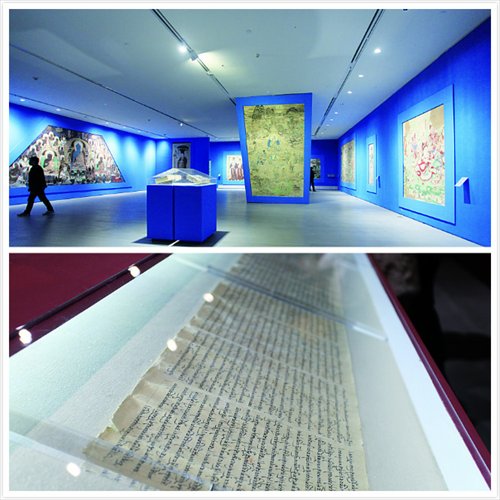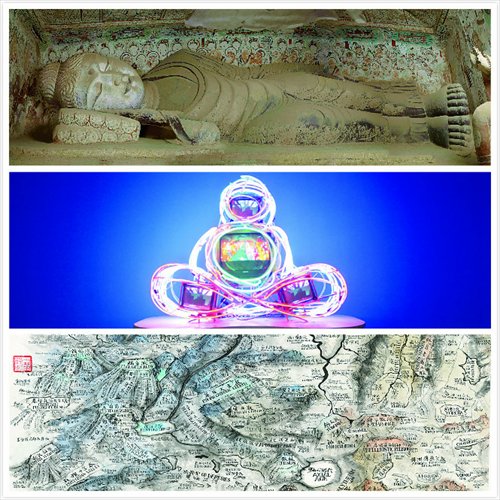Deep into art
Precious relics of Mogao Caves showcased in Shanghai
Dunhuang in Northwest China's Gansu Province carries a sense of awe in its name for Chinese people and many art lovers from around the world.
Every year, hundreds of thousands of tourists flood into the Mogao Caves, a UNESCO World Heritage Site in Dunhuang, to view the splendid art created there between the 4th and 14th centuries.
Dunhuang Academy has been the leading institute in China for the protection, management and research of Dunhuang art since the 1940s.
Together with Shanghai Himalayas Museum, Dunhuang Academy has recently brought to the city a large collection of cultural relics and Dunhuang art pieces.
Among them are replicas of the eight most significant caves in Dunhuang, six of which can't be accessed by tourists to preserve the art.
Dunhuang - Song of Living Beings consists of four parts: eight replica grottoes; a "dialogue" between contemporary Chinese artists and Dunhuang's murals, painted sculptures, silk paintings and manuscripts; Essence of the Ancient Silk Road featuring the culture and history of Dunhuang through historical bronze statues as well as documentary photos and texts; and recreations of historic sites and landscapes of Dunhuang such as Yumen Pass at the plaza outside the museum.

(From top) A view of the exhibition Dunhuang - Song of Living Beings and a manuscript showcased at the exhibition Photos: Courtesy of Shanghai Himalayas Museum and Yan Haibo
Meanwhile, an extra education section on the 3rd floor showcases basic procedures for making murals and statues according to ancient methods.
The first museum-scale exhibition of Dunhuang in Shanghai, the exhibition offers 165 sets of valuable artworks from Dunhuang, among them 20 precious historical items (nine are recognized by the government as top grade in value), 12 replicas of colored statues, 60 mural replicas, and 25 sets of replicas of silk paper paintings and manuscripts.
Most of the replicas are made by artists at Dunhuang Academy. Since the 1940s, the academy has completed digitalization of 80 grottoes and made replicas of 10.
The eight replications on view at the exhibition depict different styles of Dunhuang art through its early, middle and late periods, according to Luo Huaqing, deputy director of Dunhuang Academy.
Of the 492 Dunhuang grottoes, more than half were created during the Tang Dynasty (618-907). They are also the most precious caves due to their diversified content and refined artistry.
The exhibition showcases four caves created during the Sui (581-618) and Tang dynasties, including one containing a 15.8-meter-long statue of Buddha lying on his side (pictured below).

The No.275 Cave built during the Northern Liang Dynasty (397-439), the early period of Dunhuang art, will leave the museum in January for a future exhibition in the US to commemorate the 25th anniversary of cooperation between Dunhuang Academy and Getty Research Institute in Los Angeles.
Lee Yong-woo, curator of the museum and artistic director of the exhibition, elaborated on the exhibition title, saying that Dunhuang art is about daily life there in ancient times, and depicts all the different idols used in the practice of Buddhism.
In the exhibition space, Dunhuang art pieces are juxtaposed with contemporary artworks by 21 renowned contemporary artists.
Blue Buddha (center) by "father of video art" Nam June Paik, is an Buddha-shaped installation made of a pile of TV sets and neon lights, which evokes an interesting contrast to the serene and peaceful glory of Buddhism through its rapidly changing images and lights.
Dunhuang art serves as precious material to study Chinese paintings created before the Tang Dynasty.
Qiu Zhijie brings to the exhibition his World Map Project (above), which presents a topographic conceptual map of culture integrating research, writing, daydreaming and travel plans.
Qiu said that he had wished to become a Dunhuang expert when he was young but "unfortunately" became a contemporary artist.
Visiting Dunhuang has been a significant experience for him and his art students.
Wong Shun-kit, the curator of the contemporary art section, told the Global Times that by juxtaposing contemporary artworks with Dunhuang ancient art, he hopes to create a dialogue bridging the present and the past and a multi-layered experience for audience.
Professional tour guides from Dunhuang are available at the museum offering daily guidance; meanwhile visitors can also scan a QR code for free audio guidance.
Date: Until March 20, 10 am to 6 pm (closed Mondays)
Venue: Shanghai Himalayas Museum
上海喜玛拉雅美术馆
Address: 869 Yinghua Road
樱花路869号
Tickets: 55 yuan ($8.60) to 85 yuan
Call 5033-9801 for details